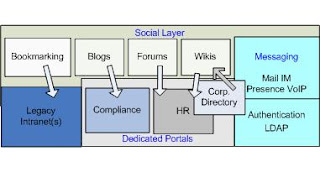“in such a way that the wiki would be the main tool used, but still in conjunction with the already existing” [intranet type apps]
As a result I decided to try to represent, in diagram form, my vision of this integration of old with new:
As a result I decided to try to represent, in diagram form, my vision of this integration of old with new:
The new social tools are used by the workforce community to talk sometimes, about content that can be found within the legacy intranet(s) and within the dedicated (specialist) portals. Also, documents bound eventually for these “locked-down” dedicated portals might start life as a collaboratively authored document within the wiki.
In the opposite direction, basic workforce information flows from the formal HR systems to form the skeletal person pages within the wiki. The employee can then embellish these with the more social/transient sections (languages I speak, web sites(or intranet pages!) I find interesting, projects I am working on)
Luis goes on: “The key towards a successful implementation and deployment of social computing tools behind the corporate firewall is not going to be on the substitution of already existing collaborative tools, but in the integration, consolidation and augmentation of what is already available”
In my book, the definition of Web 2.0 is user-created content. If a social book- marking tool can be deployed over the top of the legacy intranets then users (the workforce) will use it to decide to reinvigorate the parts of the legacy intranet that the crowd judges to be still useful/relevant, by linking to it.
“by providing different ways on how those same tools would merge and integrate with the collaboration and knowledge sharing flow of what is already available”
As Dennis Howlett put it last week:
“There is no requirement to ditch incumbent applications that continue to deliver value"
A big thank you to Luis for so eloquently wording what must be our shared vision and also for his kind words about my contribution.
Comments?
In the opposite direction, basic workforce information flows from the formal HR systems to form the skeletal person pages within the wiki. The employee can then embellish these with the more social/transient sections (languages I speak, web sites(or intranet pages!) I find interesting, projects I am working on)
Luis goes on: “The key towards a successful implementation and deployment of social computing tools behind the corporate firewall is not going to be on the substitution of already existing collaborative tools, but in the integration, consolidation and augmentation of what is already available”
In my book, the definition of Web 2.0 is user-created content. If a social book- marking tool can be deployed over the top of the legacy intranets then users (the workforce) will use it to decide to reinvigorate the parts of the legacy intranet that the crowd judges to be still useful/relevant, by linking to it.
“by providing different ways on how those same tools would merge and integrate with the collaboration and knowledge sharing flow of what is already available”
As Dennis Howlett put it last week:
“There is no requirement to ditch incumbent applications that continue to deliver value"
A big thank you to Luis for so eloquently wording what must be our shared vision and also for his kind words about my contribution.
Comments?

1 comment:
Hi Alek! What an excellent follow up post to the conversations we have been having! I really liked the graphic as I feel it is very much descriptive of what is going on in the corporate world and how things may not be as difficult as some try to paint for us. I particularly enjoyed this quote:
"In my book, the definition of Web 2.0 is user-created content. If a social book- marking tool can be deployed over the top of the legacy intranets then users (the workforce) will use it to decide to reinvigorate the parts of the legacy intranet that the crowd judges to be still useful/relevant, by linking to it."
I think you are spot on! And it certainly matches some of the stuff I have been saying myself as well, that for social media to succeed in the corporate world there is no need to kill what is already available, but grab the best of it, enhance it with the social software spice here and there and let the knowledge workers decide what would be the winner and stick with it. Chances are that thanks to that co-creation process they would be picking up the best of those legacy systems and make them even better, without having to replace anything for that matter!
Thanks again for sharing your thoughts on this subject and for dropping by at my blog to leave some further comments. Appreciated!
Post a Comment